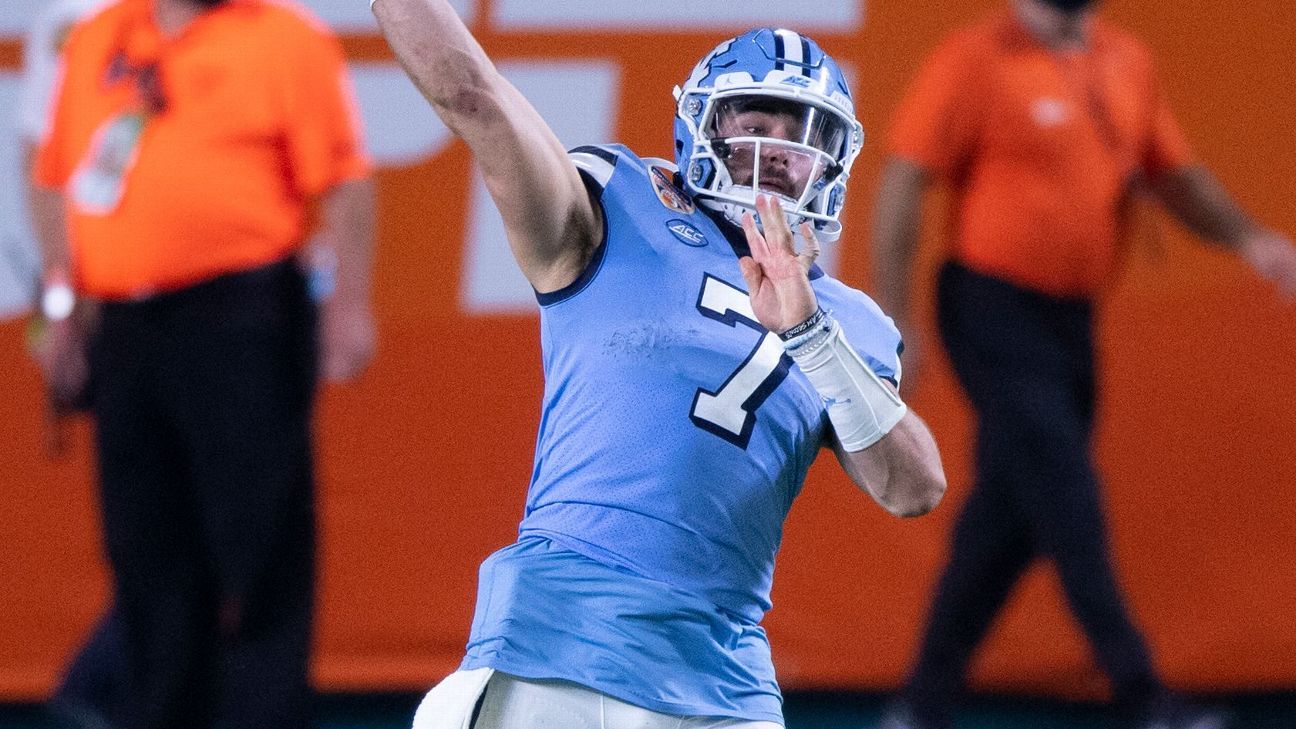Explosiveness is fun. It creates crowd pops (when there are crowds). It wins games. When an explosive player is on the college football field, keep your eye on him at all times.
Of course, “explosive” means many things. Maybe it’s a terrifying return man, or a beautiful deep ball thrower (or catcher!), or a pass-rusher who explodes into the backfield, or a one-cut-and-go running back.
A lot of college football’s most explosive players from 2020 are now preparing to find out where they’re getting drafted, but a lot are returning to school this fall. No matter the definition of choice, here are the most explosive players in college football (based on both specific rankings criteria and my own creative liberties).
Best deep-ball throwers
Few things in the sport are more hypnotic than a good deep ball. It’s one of the only explosive plays viewers can prepare for. The crowd makes a rising, humming sound before exploding when the pass is completed. And some are much better at these throws than others.
Rankings criteria: a minimum of 10 passes with air yardage of at least 20 yards. Players are ranked by completion percentage on these passes, yards per completion, percentage of catchable passes and interception rate, weighted heavily toward the first two categories.

5. Dustin Crum, Kent State
Stat line: 18 attempts, 50% completion rate, 38.8 yards per completion, 56% catchability, 0% INT rate
Wear them down by throwing sideline to sideline on repeat, then hit them vertically. Kent State’s offense is all sorts of fun.

4. Kaleb Eleby, Western Michigan
Stat line: 27 attempts, 41% completion rate, 45.4 yards per completion, 52% catchability, 0% INT rate
Thanks to his extreme short-ball accuracy and willingness to go deep, Eleby combined a 65% completion rate with an average of 17.3 yards per completion last season. The Broncos could be an outright handful for Michigan and Pitt in non-conference play.

3. Matt Corral, Ole Miss
Stat line: 56 attempts, 54% completion rate, 40.9 yards per completion, 63% catchability, 9% INT rate
He’ll be playing without deep threat Elijah Moore and tight end Kenny Yeboah this fall, but Corral still has the confidence, the arm and the aggressive playcalling of Lane Kiffin going for him.

2. Layne Hatcher, Arkansas State
Stat line: 62 attempts, 50% completion rate, 40.0 yards per completion, 65% catchability, 2% INT rate
Nearly one-third of Hatcher’s passes were 20+ yards downfield, and he throws an extremely catchable ball. New head coach Butch Jones and offensive coordinator Keith Heckendorf would be well-served by letting him cook.

1. Sam Howell, North Carolina
Stat line: 56 attempts, 45% completion rate, 42.0 yards per completion, 64% catchability, 4% INT rate
Anyone who watched UNC last year probably knew who No. 1 would be. Howell has a new skill corps at his disposal this year, but with youngsters like Khafre Brown and Josh Downs, he’ll still be able to go long when he wants to (which is often).
Best deep-ball catchers
Even the best deep-ball thrower still needs someone to reel the pass in.
Rankings criteria: at least 1.5 targets per game with air yardage of 20+ yards. Players are ranked on catch rate and yards per catch, with extra credit given to larger target numbers.

5. Romeo Doubs, Nevada
Stat line: 3.3 long targets per game, 37% catch rate, 48.9 yards per catch
The Matt Mumme offense is one of quick, easy efficiency throws. Nevada is one of the favorites in the MWC West, however, because Doubs will punish any defensive back who anticipates the short ball.

4. Jaylon Robinson, UCF
Stat line: 2.0 long targets per game, 55% catch rate, 42.2 yards per catch
New head coach Gus Malzahn inherits a skill corps hit pretty hard by attrition, but quarterback Dillon Gabriel will still have both Robinson and Ryan O’Keefe, under-6-foot speedsters who each averaged at least 17.8 yards per catch.

3. Jalen Nailor, Michigan State
Stat line: 2.4 long targets per game, 41% catch rate, 46.7 yards per catch
If Michigan State was making a big play in 2020, it was almost certainly Nailor or freshman Ricky White doing the damage. Just imagine what Nailor could do with any semblance of a run game for opponents to fear.

2. Jaylen Hall, Western Michigan
Stat line: 2.2 long targets per game, 46% catch rate, 50.6 yards per catch
Eleby-to-Hall is one of the most proven and scary combinations in the country.
0:34
Kaleb Eleby rolls out and finds Jaylen Hall for a 49-yard touchdown.

1. Khalil Shakir, Boise State
Stat line: 2.4 long targets per game, 53% catch rate, 40.2 yards per catch
As with Nailor, Shakir was saddled with having to make most of his team’s big plays. But damned if he didn’t pull it off quite a bit.
Best risk-free explosiveness
There is a general assumption that big plays require risk. Teams establish a good run game or quick passing game to lull the defense to sleep, then try to catch them over the top, right? Well, some players can take those risk-free short balls — handoffs or super short passes — and take them a very long way. Call this category “College Football’s New Travis Etiennes.”
Rankings criteria: We’ll call a risk-free big play either a rush of 15+ yards or a reception of 15+ yards with air yardage of three or fewer yards. Short passes and handoffs. To make the list, players need at least one of each. Players are ranked on both frequency and magnitude of these big plays.

5. Brittain Brown, UCLA
Stat line: 14 big plays for 353 yards, 16% frequency
The Duke transfer helped make Chip Kelly’s third UCLA offense by far his scariest. It should be equally dangerous in 2021.

4. Jarek Broussard, Colorado
Stat line: 16 big plays for 480 yards, 10% frequency
Broussard isn’t the most efficient back in the country, but he’s a lit firecracker. And he does a lot of his best work after a tackle attempt — he averaged 3.7 yards after carry per rush in 2020.

3. Tyler Allgeier, BYU
Stat line: 24 big plays for 663 yards, 16% frequency
Quarterback Zach Wilson‘s success in 2020 distracted us from the fact that the 220-pound Allgeier is maybe the most physical big-play threat in the country.

2. Bijan Robinson, Texas
Stat line: 15 big plays for 504 yards, 17% frequency
The blue-chip freshman exploded late in 2020, averaging 12 carries for 131 yards, plus two catches for an additional 33 yards, over the final four games of the season. Steve Sarkisian should have fun with him.
0:43
Bijan Robinson puts a WVU defender in a spin cycle and stiff arms another to break free, but the refs call him out of bounds.

1. Rachaad White, Arizona State
Stat line: 10 big plays for 396 yards, 22% frequency
ASU played only four games, but White made about as exciting an impression as possible, averaging 10 yards per carry and 19 yards per catch.
Most explosive tight ends
A good 195-pound sprinter is certainly fun, but isn’t it even more fun watching a 245-pounder thundering around in the open field?
Rankings criteria: tight ends with at least two targets per game. Players are ranked by yards per catch and yards after catch (per catch) — an aesthetic choice on my part — with extra credit given to players with more targets. It was calibrated so that Florida’s Kyle Pitts ranked No. 1 for 2020. He’s the model.

5. Bryson Cannon, Eastern Michigan
Stat line: 3.0 targets per game, 19.8 yards per catch, 11.9 yards after catch
Take a short pass and go a long way with it. Cannon is about the most explosive guy in a 6-foot-2, 242-pound package.

4. James Mitchell, Virginia Tech
Stat line: 4.3 targets per game, 16.7 yards per catch, 10.1 yards after catch
Mitchell’s an old(ish)-school, line-up-next-to-the-line tight end who hits the seam as well as anyone. When he had 50+ receiving yards, Virginia Tech averaged nearly six more points per game than when he didn’t.

3. Trey McBride, Colorado State
Stat line: 8.8 targets per game, 15.0 yards per catch, 7.3 yards after catch
CSU’s passing game was unique. Only two players caught more than eight passes in their four games — a tight end (McBride) and a slot man (Dante Wright) — and both averaged more than 15 yards per catch.

2. Isaiah Likely, Coastal Carolina
Stat line: 4.5 targets per game, 20.0 yards per catch, 7.0 yards after catch
Few things are more demoralizing for a defense than when it can’t stop a super-efficient run game, and then it loses track of their damned blocking tight end for just a beat or two, and he torches opponents for 20 yards.
0:27
Grayson McCall goes deep to Isaiah Likely, who takes it to the house for a Chanticleers touchdown.

1. Greg Dulcich, UCLA
Stat line: 5.7 targets per game, 19.9 yards per catch, 7.1 yards after catch
UCLA wideouts didn’t prove a ton in 2020, but the Bruins had a scary slot man (Kyle Philips), a dual-threat running back (Brown) and, in the 220-pound Dulcich, one of the most dynamite tight ends around.
Scariest pass rushers, defensive end edition
Chase Young never threw or caught a deep bomb at Ohio State, but he was as explosive as anyone in the sport in 2019. Here are the most explosive returning pass rushers at the end position.
Rankings criteria: minimum 15 pass rush attempts per game, minimum three games. Players are ranked by sack rate and pressure rate, with bonus points given to those with more attempts.

5. Kameron Butler, Miami (OH)
Stat line: 21.3 pass rushes per game, 3.9% sack rate, 15.6% pressure rate
The RedHawks start the year with road trips to Cincinnati and Minnesota. Quarterbacks Desmond Ridder and Tanner Morgan should take heed of where Butler is at all times.

4. Will McDonald, Iowa State
Stat line: 16.7 pass rushes per game, 5.3% sack rate, 17.0% pressure rate
With the loss of fellow end JaQuan Bailey, McDonald will likely be asked to play a more all-around role in 2021. If he’s as good at other things as he is at getting after the QB, he’s a potential All-American.

3. Cade Hall, San José State
Stat line: 34.3 pass rushes per game, 4.2% sack rate, 15.0% pressure rate
The MWC’s reigning defensive player of the year has a hell of a battery mate in fellow end Viliami Fehoko. The two combined for 23 TFLs and 16 sacks in just eight games.

2. Tyler Johnson, Arizona State
Stat line: 21.8 pass rushes per game, 5.7% sack rate, 18.4% pressure rate
What’s scarier: the fact that McDonald had five sacks and forced seven incompletions and interceptions in only 156 snaps, or the fact that he did that while weighing in at 285 pounds?

1. Scott Patchan, Colorado State
Stat line: 32.3 pass rushes per game, 4.3% sack rate, 17.1% pressure rate
Patchan’s career has been a journey. A member of the recruiting class of 2015 — the same class as established pros like Calvin Ridley and Christian Wilkins — he transferred from Miami in 2020 and made a living in MWC backfields. He evidently enjoyed Fort Collins so much (and who could blame him?) that he’s coming back for more.
Scariest pass rushers, linebacker edition
Granted, there are plenty of hybrid defenders these days — guys who line up with their hand in the dirt one play and upright the next. But based solely on how their school lists their position, here are the best pass-rushing linebackers for 2021.
Rankings criteria: same as above, but with a minimum of 10 pass rush attempts per game.

5. Leo Chenal, Wisconsin
Stat line: 10.7 pass rushes per game, 4.0% sack rate, 18.7% pressure rate
The Endless Wisconsin Linebacker Assembly Line has done some of its best work of late. Chenal is one of a few particularly disruptive forces coordinator Jim Leonhard will have at his disposal.

4. Micah McFadden, Indiana
Stat line: 14.0 pass rushes per game, 5.4% sack rate, 17.9% pressure rate
The Hoosiers’ leading tackler was also one of its most disruptive dudes, recording 11 TFLs, six sacks and a pair of interceptions.

3. Nik Bonitto, Oklahoma
Stat line: 16.7 pass rushes per game, 4.8% sack rate, 22.2% pressure rate
The only Power 5 defender who forced more incompletions or interceptions than Bonitto was Alabama’s Will Anderson Jr. Bonitto recorded more sacks, though, and on nearly half as many pass rush attempts.

2. Durell Nchami, Maryland
Stat line: 12.7 pass rushes per game, 5.3% sack rate, 21.1% pressure rate
After missing 2019 with an ACL tear, Nchami missed two of Maryland’s five 2020 games with injury, too. If he can stay on the field, he’s an absolute menace.

1. Zion Tupuola-Fetui, Washington
Stat line: 21.5 pass rushes per game, 8.1% sack rate, 16.3% pressure rate
One of the Pac-12’s true 2020 breakout stars, he recorded seven sacks in just four games. Played over a normal-length season that’s a pace for 20+.
Big dudes who live in the backfield
There might not be a scarier weapon in the sport than a defensive tackle (or maybe just a really big end) that teams can’t keep out of the backfield.
Rankings criteria: minimum 20 snaps per game, minimum three games and, to account for the blurriness of position names up front, a minimum of 280 pounds. Players are ranked by the number of stops they make — against run or pass — at or behind the line of scrimmage. On these plays, you might as well have just taken the snap and spiked the ball into the ground. It would have been less demoralizing.

5. Ralph Holley, Western Michigan (6-foot-2, 285)
Stat line: 60.3 snaps per game, 15 total stops (4.1% of snaps)
One of the smaller nose guards here, Holley (a) is still a big dude and (b) took full advantage of his quickness on the interior of MAC lines.

4. Jermayne Lole, Arizona State (6-foot-1, 310)
Stat line: 62.8 snaps per game, 11 total stops (4.4% of snaps)
Not only is Lole listed at 310 pounds, and not only did he make more than half his stops at or behind the line last year … he’s also equally active everywhere. He was credited with 72 total tackles in 2019, third-most on the team.

3. Avien Peah, UMass (6-foot-2, 280)
Stat line: 29.8 snaps per game, 12 total stops (10.1% of snaps)
UMass got pushed around for most of its humbling four-game 2020 campaign, but Peah did some pushing back. He was the only defensive lineman who made a stop at or behind the line on 10% of his snaps.

2. Nick Figueroa, USC (6-foot-5, 280)
Stat line: 43.5 snaps per game, 13 total stops (5.0% of snaps)
Overshadowed by star defenders like Talanoa Hufanga and Drake Jackson, Figueroa was a plus-pass rusher and sturdy run defender, and he even dropped into coverage 14 times.

1. Tyler Johnson, Arizona State (6-foot-4, 285)
Stat line: 39.0 snaps per game, 9 total stops (5.8% of snaps)
That’s right: It’s Johnson’s second appearance on the list. It is unfair to be this big and this disruptive. (Arizona State, meanwhile, has a lot of guys in this piece. The Sun Devils are going to be fast and awfully fun this fall.)
Most disruptive defensive backs
One of the primary jobs of a secondary is to serve as killjoys and prevent big plays. But there are still plenty of havoc creators at defensive back as well.
Rankings criteria: minimum 20 snaps per game, minimum three games, minimum two tackles for loss and two passes defensed (intercepted or broken up). Players are ranked by havoc rate — tackles for loss, passes defensed and forced fumbles divided by total snaps — with bonus points given to those with more snaps.

5. Scott Nelson, Wisconsin
Stat line: 45.0 snaps per game, 8 havoc plays (4 TFL, 4 passes defensed), 3.0% havoc rate
Leonhard used the 6-foot-2, 204-pounder in countless ways, from coverage to pass rushing. He’s at his best close to the line of scrimmage.

4. Mekhi Garner, Louisiana
Stat line: 42.9 snaps per game, 14 havoc plays (12 passes defensed, 2 TFL), 3.0% havoc rate
UL deploys a lot of man coverage; this safety-sized cornerback (6-foot-2, 212) is among the stickiest and most disruptive cover guys in the country.

3. Samuel Womack, Toledo
Stat line: 57.7 snaps per game, 10 havoc plays (8 passes defensed, 2 TFL), 2.9% havoc rate
The senior, former walk-on and Burlsworth Trophy nominee led the MAC in pass breakups and made two stops behind the line as well.

2. Tiawan Mullen, Indiana
Stat line: 51.5 snaps per game, 14 havoc plays (9 passes defensed, 4 TFL, 1 FF), 3.4% havoc rate
Mullen has been one of the best players on the IU roster from the moment he set foot in Bloomington in 2019. It’s not hard to figure out why he earned All-America honors last fall.

1. Jalen Pitre, Baylor
Stat line: 60.4 snaps per game, 20 havoc plays (13 TFL, 6 passes defensed, 1 FF), 3.7% havoc rate
One of the best nickelbacks in the country, Pitre went from redshirting in 2019 to earning first-team all-conference honors in 2020.
Punters need love, too
You can’t tell me that big Pressley Harvin III wasn’t must-watch TV last fall. Sadly, Georgia Tech’s 255-pound punter is off to the pros, but some big legs remain.
Rankings criteria: minimum 10 punts with at least one over 50. Bonus points for having some downed inside the 10, too. Diversification!

3. Austin McNamara, Texas Tech
Stat line: 41 punts, 46.3 average, long of 87, 7% inside the 10
I mean, yes, of course I’m going to include the guy with the 87-yard punt. An 87-yard anything is explosive.

2. Jake Camarda, Georgia
Stat line: 36 punts, 46.6 average, long of 64, 19% inside the 10
His usage sank toward the end of the season as Georgia’s offense broke out, but few punters combine his length with his pin-you-deep accuracy. The football equivalent of a good long-iron game.

1. Julian Diaz, Nevada
Stat line: 23 punts, 46.3 average, long of 76, 17% inside the 10
Diaz is the Camarda of the West, and he lands at the top here because of the 76-yarder he uncorked in the season opener against Wyoming. It pinned the Cowboys at the 10 and set up a go-ahead score in the fourth quarter.
Best deep-ball kickers
It’s a sign of trust when a head coach even asks his college kicker to attempt a field goal beyond 50 yards. That faith is occasionally rewarded as well.
Rankings criteria: Let’s keep this one simple. Players are ranked by how they fared on field goals of 50+ yards.

3. Gabe Brkic, Oklahoma
Stat line: 4-for-7 over 50 yards, 20-for-26 overall, average attempt of 36.3
Brkic was a bit more volatile than the two other kickers here, but hey, a few shanks into the rough are often part of the “long driver” package.

2. Harrison Mevis, Missouri
Stat line: 3-for-4 over 50 yards, 17-for-20 overall, average attempt of 35.0
In 2020, Mevis was one thing the other two guys on this list weren’t: a freshman. The Tigers are set at kicker for a while.

1. Cade York, LSU
Stat line: 6-for-7 over 50 yards, 18-for-21 overall, average attempt of 40.2
Only one kicker in 2020 killed (or at least mortally wounded) a team’s national title hopes with a 57-yard, last-minute bomb: York, against Florida. His range is endless.
Most terrifying returners
Even as kick returns slowly get phased out of the game a bit, there are still few things more explosive and exciting than a big return. Here are the guys most likely to deliver such a thing.
Rankings criteria: 10 returns of some sort. Players are ranked by their frequency of gaining either 30+ yards on kick returns or 20+ yards on punt returns.

3. Nykeim Johnson, Kent State (via Syracuse)
Stat line: 12 punt returns, 14.1 average, 33% of returns 20+ yards
A solid slot receiver and great return man, Johnson gives Kent State a potential difference maker upon his move from the ACC.

2. D’Shawn Jamison, Texas
Stat line: 17 kick returns, 33.2 average, 1 TD, 35% of returns 30+ yards
He didn’t do much on 10 punt returns, but teams kicking off against Texas are much better off just booting the ball through the end zone.

1. Britain Covey, Utah
Stat line: 4 kick returns, 28.3 average, 50% of returns 30+ yards; 8 punt returns, 16.1 average, 1 TD, 25% of returns over 20
What a career: Covey has earned all-conference honors as a return man in three different years: 2015, 2018 and 2020. He served an LDS mission in 2016-17, missed 2019 with an ACL injury and came back stronger each time.
